Netty网络编程第一卷_transfrompath(config.baseurl, identifier, endswith-程序员宅基地
技术标签: java 网络 # Netty框架源码探究 # NIO 开发语言
Netty第一卷
一. NIO 基础
non-blocking io 非阻塞 IO
1. 三大组件
1.1 Channel & Buffer
channel 有一点类似于 stream,它就是读写数据的双向通道,可以从 channel 将数据读入 buffer,也可以将 buffer 的数据写入 channel,而之前的 stream 要么是输入,要么是输出,channel 比 stream 更为底层
常见的 Channel 有
- FileChannel
- DatagramChannel
- SocketChannel
- ServerSocketChannel
buffer 则用来缓冲读写数据,常见的 buffer 有
- ByteBuffer
- MappedByteBuffer
- DirectByteBuffer
- HeapByteBuffer
- ShortBuffer
- IntBuffer
- LongBuffer
- FloatBuffer
- DoubleBuffer
- CharBuffer
1.2 Selector
selector 单从字面意思不好理解,需要结合服务器的设计演化来理解它的用途
多线程版设计
️ 多线程版缺点
- 内存占用高
- 线程上下文切换成本高
- 只适合连接数少的场景
线程池版设计
️ 线程池版缺点
- 阻塞模式下,线程仅能处理一个 socket 连接
- 仅适合短连接场景
selector 版设计
selector 的作用就是配合一个线程来管理多个 channel,获取这些 channel 上发生的事件,这些 channel 工作在非阻塞模式下,不会让线程吊死在一个 channel 上。适合连接数特别多,但流量低的场景(low traffic)
调用 selector 的 select() 会阻塞直到 channel 发生了读写就绪事件,这些事件发生,select 方法就会返回这些事件交给 thread 来处理
依赖
<dependency>
<groupId>ch.qos.logback</groupId>
<artifactId>logback-classic</artifactId>
<version>1.3.0-alpha4</version>
</dependency>
<dependency>
<groupId>com.google.code.gson</groupId>
<artifactId>gson</artifactId>
<version>2.8.6</version>
</dependency>
<dependency>
<groupId>io.netty</groupId>
<artifactId>netty-all</artifactId>
<version>4.1.66.Final</version>
</dependency>
<dependency>
<groupId>com.google.guava</groupId>
<artifactId>guava</artifactId>
<version>30.1.1-jre</version>
</dependency>
2. ByteBuffer
有一普通文本文件 data.txt,内容为
1234567890abcd
使用 FileChannel 来读取文件内容
@Slf4j
public class ChannelDemo1 {
public static void main(String[] args) {
try (RandomAccessFile file = new RandomAccessFile("helloword/data.txt", "rw")) {
FileChannel channel = file.getChannel();
ByteBuffer buffer = ByteBuffer.allocate(10);
do {
// 向 buffer 写入
int len = channel.read(buffer);
log.debug("读到字节数:{}", len);
if (len == -1) {
break;
}
// 切换 buffer 读模式
buffer.flip();
while(buffer.hasRemaining()) {
log.debug("{}", (char)buffer.get());
}
// 切换 buffer 写模式
buffer.clear();
} while (true);
} catch (IOException e) {
e.printStackTrace();
}
}
}
输出
10:39:03 [DEBUG] [main] c.i.n.ChannelDemo1 - 读到字节数:10
10:39:03 [DEBUG] [main] c.i.n.ChannelDemo1 - 1
10:39:03 [DEBUG] [main] c.i.n.ChannelDemo1 - 2
10:39:03 [DEBUG] [main] c.i.n.ChannelDemo1 - 3
10:39:03 [DEBUG] [main] c.i.n.ChannelDemo1 - 4
10:39:03 [DEBUG] [main] c.i.n.ChannelDemo1 - 5
10:39:03 [DEBUG] [main] c.i.n.ChannelDemo1 - 6
10:39:03 [DEBUG] [main] c.i.n.ChannelDemo1 - 7
10:39:03 [DEBUG] [main] c.i.n.ChannelDemo1 - 8
10:39:03 [DEBUG] [main] c.i.n.ChannelDemo1 - 9
10:39:03 [DEBUG] [main] c.i.n.ChannelDemo1 - 0
10:39:03 [DEBUG] [main] c.i.n.ChannelDemo1 - 读到字节数:4
10:39:03 [DEBUG] [main] c.i.n.ChannelDemo1 - a
10:39:03 [DEBUG] [main] c.i.n.ChannelDemo1 - b
10:39:03 [DEBUG] [main] c.i.n.ChannelDemo1 - c
10:39:03 [DEBUG] [main] c.i.n.ChannelDemo1 - d
10:39:03 [DEBUG] [main] c.i.n.ChannelDemo1 - 读到字节数:-1
2.1 ByteBuffer 正确使用姿势
- 向 buffer 写入数据,例如调用 channel.read(buffer)
- 调用 flip() 切换至读模式
- 从 buffer 读取数据,例如调用 buffer.get()
- 调用 clear() 或 compact() 切换至写模式
- 重复 1~4 步骤
2.2 ByteBuffer 结构
ByteBuffer 有以下重要属性
- capacity
- position
- limit
一开始
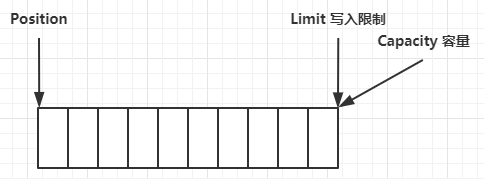
写模式下,position 是写入位置,limit 等于容量,下图表示写入了 4 个字节后的状态
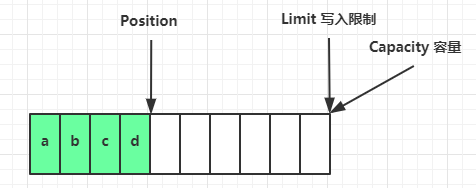
flip 动作发生后,position 切换为读取位置,limit 切换为读取限制
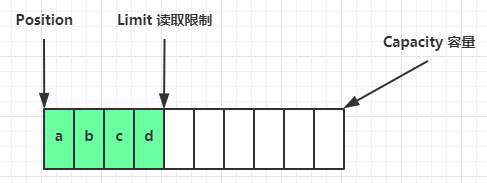
读取 4 个字节后,状态
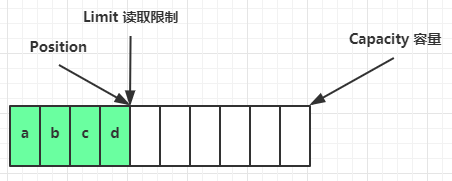
clear 动作发生后,状态
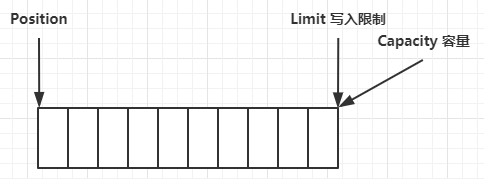
compact 方法,是把未读完的部分向前压缩,然后切换至写模式

调试工具类
可以在控制台上面输出当前Buffer的详细情况,内部用到了guava和netty-all jar包中的相关类
public class ByteBufferUtil {
private static final char[] BYTE2CHAR = new char[256];
private static final char[] HEXDUMP_TABLE = new char[256 * 4];
private static final String[] HEXPADDING = new String[16];
private static final String[] HEXDUMP_ROWPREFIXES = new String[65536 >>> 4];
private static final String[] BYTE2HEX = new String[256];
private static final String[] BYTEPADDING = new String[16];
static {
final char[] DIGITS = "0123456789abcdef".toCharArray();
for (int i = 0; i < 256; i++) {
HEXDUMP_TABLE[i << 1] = DIGITS[i >>> 4 & 0x0F];
HEXDUMP_TABLE[(i << 1) + 1] = DIGITS[i & 0x0F];
}
int i;
// Generate the lookup table for hex dump paddings
for (i = 0; i < HEXPADDING.length; i++) {
int padding = HEXPADDING.length - i;
StringBuilder buf = new StringBuilder(padding * 3);
for (int j = 0; j < padding; j++) {
buf.append(" ");
}
HEXPADDING[i] = buf.toString();
}
// Generate the lookup table for the start-offset header in each row (up to 64KiB).
for (i = 0; i < HEXDUMP_ROWPREFIXES.length; i++) {
StringBuilder buf = new StringBuilder(12);
buf.append(NEWLINE);
buf.append(Long.toHexString(i << 4 & 0xFFFFFFFFL | 0x100000000L));
buf.setCharAt(buf.length() - 9, '|');
buf.append('|');
HEXDUMP_ROWPREFIXES[i] = buf.toString();
}
// Generate the lookup table for byte-to-hex-dump conversion
for (i = 0; i < BYTE2HEX.length; i++) {
BYTE2HEX[i] = ' ' + StringUtil.byteToHexStringPadded(i);
}
// Generate the lookup table for byte dump paddings
for (i = 0; i < BYTEPADDING.length; i++) {
int padding = BYTEPADDING.length - i;
StringBuilder buf = new StringBuilder(padding);
for (int j = 0; j < padding; j++) {
buf.append(' ');
}
BYTEPADDING[i] = buf.toString();
}
// Generate the lookup table for byte-to-char conversion
for (i = 0; i < BYTE2CHAR.length; i++) {
if (i <= 0x1f || i >= 0x7f) {
BYTE2CHAR[i] = '.';
} else {
BYTE2CHAR[i] = (char) i;
}
}
}
/**
* 打印所有内容
* @param buffer
*/
public static void debugAll(ByteBuffer buffer) {
int oldlimit = buffer.limit();
buffer.limit(buffer.capacity());
StringBuilder origin = new StringBuilder(256);
appendPrettyHexDump(origin, buffer, 0, buffer.capacity());
System.out.println("+--------+-------------------- all ------------------------+----------------+");
System.out.printf("position: [%d], limit: [%d]\n", buffer.position(), oldlimit);
System.out.println(origin);
buffer.limit(oldlimit);
}
/**
* 打印可读取内容
* @param buffer
*/
public static void debugRead(ByteBuffer buffer) {
StringBuilder builder = new StringBuilder(256);
appendPrettyHexDump(builder, buffer, buffer.position(), buffer.limit() - buffer.position());
System.out.println("+--------+-------------------- read -----------------------+----------------+");
System.out.printf("position: [%d], limit: [%d]\n", buffer.position(), buffer.limit());
System.out.println(builder);
}
private static void appendPrettyHexDump(StringBuilder dump, ByteBuffer buf, int offset, int length) {
if (isOutOfBounds(offset, length, buf.capacity())) {
throw new IndexOutOfBoundsException(
"expected: " + "0 <= offset(" + offset + ") <= offset + length(" + length
+ ") <= " + "buf.capacity(" + buf.capacity() + ')');
}
if (length == 0) {
return;
}
dump.append(
" +-------------------------------------------------+" +
NEWLINE + " | 0 1 2 3 4 5 6 7 8 9 a b c d e f |" +
NEWLINE + "+--------+-------------------------------------------------+----------------+");
final int startIndex = offset;
final int fullRows = length >>> 4;
final int remainder = length & 0xF;
// Dump the rows which have 16 bytes.
for (int row = 0; row < fullRows; row++) {
int rowStartIndex = (row << 4) + startIndex;
// Per-row prefix.
appendHexDumpRowPrefix(dump, row, rowStartIndex);
// Hex dump
int rowEndIndex = rowStartIndex + 16;
for (int j = rowStartIndex; j < rowEndIndex; j++) {
dump.append(BYTE2HEX[getUnsignedByte(buf, j)]);
}
dump.append(" |");
// ASCII dump
for (int j = rowStartIndex; j < rowEndIndex; j++) {
dump.append(BYTE2CHAR[getUnsignedByte(buf, j)]);
}
dump.append('|');
}
// Dump the last row which has less than 16 bytes.
if (remainder != 0) {
int rowStartIndex = (fullRows << 4) + startIndex;
appendHexDumpRowPrefix(dump, fullRows, rowStartIndex);
// Hex dump
int rowEndIndex = rowStartIndex + remainder;
for (int j = rowStartIndex; j < rowEndIndex; j++) {
dump.append(BYTE2HEX[getUnsignedByte(buf, j)]);
}
dump.append(HEXPADDING[remainder]);
dump.append(" |");
// Ascii dump
for (int j = rowStartIndex; j < rowEndIndex; j++) {
dump.append(BYTE2CHAR[getUnsignedByte(buf, j)]);
}
dump.append(BYTEPADDING[remainder]);
dump.append('|');
}
dump.append(NEWLINE +
"+--------+-------------------------------------------------+----------------+");
}
private static void appendHexDumpRowPrefix(StringBuilder dump, int row, int rowStartIndex) {
if (row < HEXDUMP_ROWPREFIXES.length) {
dump.append(HEXDUMP_ROWPREFIXES[row]);
} else {
dump.append(NEWLINE);
dump.append(Long.toHexString(rowStartIndex & 0xFFFFFFFFL | 0x100000000L));
dump.setCharAt(dump.length() - 9, '|');
dump.append('|');
}
}
public static short getUnsignedByte(ByteBuffer buffer, int index) {
return (short) (buffer.get(index) & 0xFF);
}
}
2.3 ByteBuffer 常见方法
分配空间
可以使用 allocate 方法为 ByteBuffer 分配空间,其它 buffer 类也有该方法
Bytebuffer buf = ByteBuffer.allocate(16);
向 buffer 写入数据
有两种办法
- 调用 channel 的 read 方法
- 调用 buffer 自己的 put 方法
int readBytes = channel.read(buf);
和
buf.put((byte)127);
从 buffer 读取数据
同样有两种办法
- 调用 channel 的 write 方法
- 调用 buffer 自己的 get 方法
int writeBytes = channel.write(buf);
和
byte b = buf.get();
get 方法会让 position 读指针向后走,如果想重复读取数据
- 可以调用 rewind 方法将 position 重新置为 0
- 或者调用 get(int i) 方法获取索引 i 的内容,它不会移动读指针
mark 和 reset
mark 是在读取时,做一个标记,即使 position 改变,只要调用 reset 就能回到 mark 的位置
注意
rewind 和 flip 都会清除 mark 位置
字符串与 ByteBuffer 互转
ByteBuffer buffer1 = StandardCharsets.UTF_8.encode("你好");
ByteBuffer buffer2 = Charset.forName("utf-8").encode("你好");
debugAll(buffer1);
debugAll(buffer2);
CharBuffer buffer3 = StandardCharsets.UTF_8.decode(buffer1);
System.out.println(buffer3.getClass());
System.out.println(buffer3.toString());
输出
下面输出的是十六进制
+--------+-------------------- all ------------------------+----------------+
position: [0], limit: [6]
+-------------------------------------------------+
| 0 1 2 3 4 5 6 7 8 9 a b c d e f |
+--------+-------------------------------------------------+----------------+
|00000000| e4 bd a0 e5 a5 bd 00 00 00 00 00 |........... |
+--------+-------------------------------------------------+----------------+
+--------+-------------------- all ------------------------+----------------+
position: [0], limit: [6]
+-------------------------------------------------+
| 0 1 2 3 4 5 6 7 8 9 a b c d e f |
+--------+-------------------------------------------------+----------------+
|00000000| e4 bd a0 e5 a5 bd 00 00 00 00 00 |........... |
+--------+-------------------------------------------------+----------------+
class java.nio.HeapCharBuffer
你好
️ Buffer 的线程安全
Buffer 是非线程安全的
2.4 Scattering Reads
分散读取,有一个文本文件 1.txt
dhyxpy1314
使用如下方式读取,可以将数据填充至多个 buffer
try (RandomAccessFile file = new RandomAccessFile("1.txt", "rw")) {
FileChannel channel = file.getChannel();
ByteBuffer a = ByteBuffer.allocate(3);
ByteBuffer b = ByteBuffer.allocate(3);
ByteBuffer c = ByteBuffer.allocate(4);
channel.read(new ByteBuffer[]{
a, b, c});
a.flip();
b.flip();
c.flip();
debugAll(a);
debugAll(b);
debugAll(c);
} catch (IOException e) {
e.printStackTrace();
}
结果
+--------+-------------------- all ------------------------+----------------+
position: [0], limit: [3]
+-------------------------------------------------+
| 0 1 2 3 4 5 6 7 8 9 a b c d e f |
+--------+-------------------------------------------------+----------------+
|00000000| 64 68 79 |dhy |
+--------+-------------------------------------------------+----------------+
+--------+-------------------- all ------------------------+----------------+
position: [0], limit: [3]
+-------------------------------------------------+
| 0 1 2 3 4 5 6 7 8 9 a b c d e f |
+--------+-------------------------------------------------+----------------+
|00000000| 78 70 79 |xpy |
+--------+-------------------------------------------------+----------------+
+--------+-------------------- all ------------------------+----------------+
position: [0], limit: [4]
+-------------------------------------------------+
| 0 1 2 3 4 5 6 7 8 9 a b c d e f |
+--------+-------------------------------------------------+----------------+
|00000000| 31 33 31 34 |1314 |
+--------+-------------------------------------------------+----------------+
2.5 Gathering Writes
使用如下方式写入,可以将多个 buffer 的数据填充至 channel
try (RandomAccessFile file = new RandomAccessFile("1.txt", "rw")) {
FileChannel channel = file.getChannel();
ByteBuffer d = ByteBuffer.allocate(3);
ByteBuffer e = ByteBuffer.allocate(3);
//设置当前文件通道初始读写的位置
channel.position(10);
d.put(new byte[]{
'f', 'o', 'r'});
e.put(new byte[]{
'g', 'e', 't'});
//切换读取模式
d.flip();
e.flip();
debugAll(d);
debugAll(e);
channel.write(new ByteBuffer[]{
d, e});
} catch (IOException e) {
e.printStackTrace();
}
输出
+--------+-------------------- all ------------------------+----------------+
position: [0], limit: [3]
+-------------------------------------------------+
| 0 1 2 3 4 5 6 7 8 9 a b c d e f |
+--------+-------------------------------------------------+----------------+
|00000000| 66 6f 72 |for |
+--------+-------------------------------------------------+----------------+
+--------+-------------------- all ------------------------+----------------+
position: [0], limit: [3]
+-------------------------------------------------+
| 0 1 2 3 4 5 6 7 8 9 a b c d e f |
+--------+-------------------------------------------------+----------------+
|00000000| 67 65 74 |get |
+--------+-------------------------------------------------+----------------+
文件内容
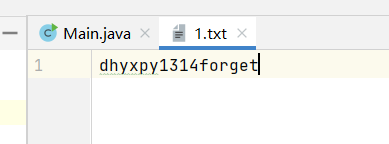
黏包和半包
网络上有多条数据发送给服务端,数据之间使用 \n 进行分隔
但由于某种原因这些数据在接收时,被进行了重新组合,例如原始数据有3条为
- Hello,world\n
- I’m zhangsan\n
- How are you?\n
变成了下面的两个 byteBuffer (黏包,半包)
- Hello,world\nI’m zhangsan\nHo
- w are you?\n
现在要求你编写程序,将错乱的数据恢复成原始的按 \n 分隔的数据
/**
* @author 大忽悠
* @create 2022/1/16 14:23
*/
public class Main
{
public static void main(String[] args) {
ByteBuffer source = ByteBuffer.allocate(32);
// 11 24
source.put("Hello,world\nI'm DHY\nHo".getBytes());
split(source);
source.put("w are you?\nhaha!\n".getBytes());
split(source);
}
private static void split(ByteBuffer source) {
//切换读写模式
source.flip();
//读的最大距离
int oldLimit = source.limit();
for (int i = 0; i < oldLimit; i++) {
//\n表示一句话读取完毕
if (source.get(i) == '\n')
{
//打印换行符的下标
System.out.println(i);
//分配的缓冲区大小为当前一句话的大小
ByteBuffer target = ByteBuffer.allocate(i + 1 - source.position());
// 0 ~ limit----设置limit的新位置
source.limit(i + 1);
//把position-->limit之间的数据全部放入target缓冲区中
target.put(source); // 从source 读,向 target 写
debugAll(target);
//恢复为原来最远读取距离
source.limit(oldLimit);
}
}
//将还未读取的数据移动到缓冲区头部
source.compact();
}
}
输出
11
+--------+-------------------- all ------------------------+----------------+
position: [12], limit: [12]
+-------------------------------------------------+
| 0 1 2 3 4 5 6 7 8 9 a b c d e f |
+--------+-------------------------------------------------+----------------+
|00000000| 48 65 6c 6c 6f 2c 77 6f 72 6c 64 0a |Hello,world. |
+--------+-------------------------------------------------+----------------+
19
+--------+-------------------- all ------------------------+----------------+
position: [8], limit: [8]
+-------------------------------------------------+
| 0 1 2 3 4 5 6 7 8 9 a b c d e f |
+--------+-------------------------------------------------+----------------+
|00000000| 49 27 6d 20 44 48 59 0a |I'm DHY. |
+--------+-------------------------------------------------+----------------+
12
+--------+-------------------- all ------------------------+----------------+
position: [13], limit: [13]
+-------------------------------------------------+
| 0 1 2 3 4 5 6 7 8 9 a b c d e f |
+--------+-------------------------------------------------+----------------+
|00000000| 48 6f 77 20 61 72 65 20 79 6f 75 3f 0a |How are you?. |
+--------+-------------------------------------------------+----------------+
18
+--------+-------------------- all ------------------------+----------------+
position: [6], limit: [6]
+-------------------------------------------------+
| 0 1 2 3 4 5 6 7 8 9 a b c d e f |
+--------+-------------------------------------------------+----------------+
|00000000| 68 61 68 61 21 0a |haha!. |
+--------+-------------------------------------------------+----------------+
3. 文件编程
3.1 FileChannel
️ FileChannel 工作模式
FileChannel 只能工作在阻塞模式下
获取
不能直接打开 FileChannel,必须通过 FileInputStream、FileOutputStream 或者 RandomAccessFile 来获取 FileChannel,它们都有 getChannel 方法
- 通过 FileInputStream 获取的 channel 只能读
- 通过 FileOutputStream 获取的 channel 只能写
- 通过 RandomAccessFile 是否能读写根据构造 RandomAccessFile 时的读写模式决定
读取
会从 channel 读取数据填充 ByteBuffer,返回值表示读到了多少字节,-1 表示到达了文件的末尾
int readBytes = channel.read(buffer);
写入
写入的正确姿势如下, SocketChannel
ByteBuffer buffer = ...;
buffer.put(...); // 存入数据
buffer.flip(); // 切换读模式
while(buffer.hasRemaining()) {
channel.write(buffer);
}
在 while 中调用 channel.write 是因为 write 方法并不能保证一次将 buffer 中的内容全部写入 channel
关闭
channel 必须关闭,不过调用了 FileInputStream、FileOutputStream 或者 RandomAccessFile 的 close 方法会间接地调用 channel 的 close 方法
位置
获取当前位置
long pos = channel.position();
设置当前位置
long newPos = ...;
channel.position(newPos);
设置当前位置时,如果设置为文件的末尾
- 这时读取会返回 -1
- 这时写入,会追加内容,但要注意如果 position 超过了文件末尾,再写入时在新内容和原末尾之间会有空洞(00)
大小
使用 size 方法获取文件的大小
强制写入
操作系统出于性能的考虑,会将数据先缓存,不是立刻写入磁盘。可以调用 force(true) 方法将文件内容和元数据(文件的权限等信息)立刻写入磁盘
3.2 两个 Channel 传输数据
String FROM = "helloword/data.txt";
String TO = "helloword/to.txt";
long start = System.nanoTime();
try (FileChannel from = new FileInputStream(FROM).getChannel();
FileChannel to = new FileOutputStream(TO).getChannel();
) {
from.transferTo(0, from.size(), to);
} catch (IOException e) {
e.printStackTrace();
}
long end = System.nanoTime();
System.out.println("transferTo 用时:" + (end - start) / 1000_000.0);
输出
transferTo 用时:8.2011
一次性最多传输2g数据,超过 2g 大小的文件传输
public class TestFileChannelTransferTo {
public static void main(String[] args) {
try (
FileChannel from = new FileInputStream("data.txt").getChannel();
FileChannel to = new FileOutputStream("to.txt").getChannel();
) {
// 效率高,底层会利用操作系统的零拷贝进行优化
long size = from.size();
// left 变量代表还剩余多少字节
for (long left = size; left > 0; ) {
System.out.println("position:" + (size - left) + " left:" + left);
//transferTo返回值表示一次传输了多少个字节
left -= from.transferTo((size - left), left, to);
}
} catch (IOException e) {
e.printStackTrace();
}
}
}
实际传输一个超大文件
position:0 left:7769948160
position:2147483647 left:5622464513
position:4294967294 left:3474980866
position:6442450941 left:1327497219
3.3 Path
jdk7 引入了 Path 和 Paths 类
- Path 用来表示文件路径
- Paths 是工具类,用来获取 Path 实例
Path source = Paths.get("1.txt"); // 相对路径 使用 user.dir 环境变量来定位 1.txt
Path source = Paths.get("d:\\1.txt"); // 绝对路径 代表了 d:\1.txt
Path source = Paths.get("d:/1.txt"); // 绝对路径 同样代表了 d:\1.txt
Path projects = Paths.get("d:\\data", "projects"); // 代表了 d:\data\projects
.代表了当前路径..代表了上一级路径
例如目录结构如下
d:
|- data
|- projects
|- a
|- b
代码
Path path = Paths.get("d:\\data\\projects\\a\\..\\b");
System.out.println(path);
System.out.println(path.normalize()); // 正常化路径
会输出
d:\data\projects\a\..\b
d:\data\projects\b
3.4 Files
检查文件是否存在
Path path = Paths.get("helloword/data.txt");
System.out.println(Files.exists(path));
创建一级目录
Path path = Paths.get("helloword/d1");
Files.createDirectory(path);
- 如果目录已存在,会抛异常 FileAlreadyExistsException
- 不能一次创建多级目录,否则会抛异常 NoSuchFileException
创建多级目录用
Path path = Paths.get("helloword/d1/d2");
Files.createDirectories(path);
拷贝文件
这里copy底层也是操作系统实现的,效率较高,和transfromto类似
Path source = Paths.get("helloword/data.txt");
Path target = Paths.get("helloword/target.txt");
Files.copy(source, target);
- 如果文件已存在,会抛异常 FileAlreadyExistsException
如果希望用 source 覆盖掉 target,需要用 StandardCopyOption 来控制
Files.copy(source, target, StandardCopyOption.REPLACE_EXISTING);
移动文件
Path source = Paths.get("helloword/data.txt");
Path target = Paths.get("helloword/data.txt");
Files.move(source, target, StandardCopyOption.ATOMIC_MOVE);
StandardCopyOption.ATOMIC_MOVE 保证文件移动的原子性
删除文件
Path target = Paths.get("helloword/target.txt");
Files.delete(target);
- 如果文件不存在,会抛异常 NoSuchFileException
删除目录
Path target = Paths.get("helloword/d1");
Files.delete(target);
- 如果目录还有内容,会抛异常 DirectoryNotEmptyException
遍历目录文件
/**
* @author 大忽悠
* @create 2022/1/16 14:23
*/
public class Main
{
public static void main(String[] args) throws IOException {
Path path = Paths.get("C:\\Users\\zdh\\Desktop\\hhh");
//累加器记录
//记录目录数量
LongAdder dirCount=new LongAdder();
//记录文件数量
LongAdder fileCount=new LongAdder();
//这里使用了访问者模式
Files.walkFileTree(path, new SimpleFileVisitor<Path>(){
@Override
public FileVisitResult preVisitDirectory(Path dir, BasicFileAttributes attrs)
throws IOException {
System.out.println(dir);
dirCount.increment();
return super.preVisitDirectory(dir, attrs);
}
@Override
public FileVisitResult visitFile(Path file, BasicFileAttributes attrs)
throws IOException {
System.out.println(file);
fileCount.increment();
return super.visitFile(file, attrs);
}
});
System.out.println("目录数量: "+dirCount); // 133
System.out.println("文件数量: "+fileCount); // 1479
}
}
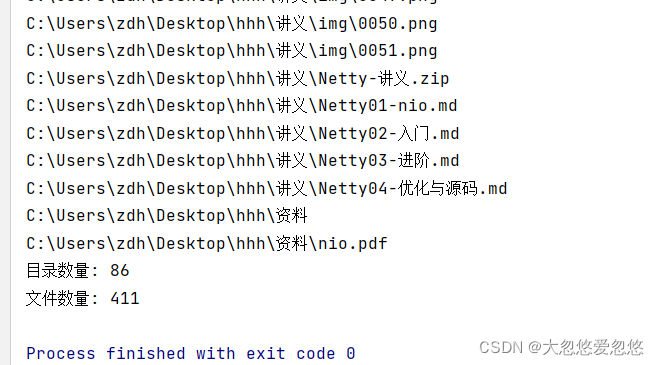
Path.endswith() 的是 Path 不是文件名后缀
Path.endswith() 的是 Path 不是文件名后缀
统计.png文件的数量:
/
* @author 大忽悠
* @create 2022/1/16 14:23
*/
public class Main
{
public static void main(String[] args) throws IOException {
Path path = Paths.get("C:\\Users\\zdh\\Desktop\\hhh");
//累加器记录
//记录文件数量
LongAdder fileCount=new LongAdder();
//这里使用了访问者模式
Files.walkFileTree(path, new SimpleFileVisitor<Path>(){
@Override
public FileVisitResult visitFile(Path file, BasicFileAttributes attrs)
throws IOException {
if(file.toFile().getName().endsWith(".png"))
{
System.out.println(file);
fileCount.increment();
}
return super.visitFile(file, attrs);
}
});
System.out.println("文件数量: "+fileCount); // 1479
}
}

删除多级目录
public class Main
{
public static void main(String[] args) throws IOException {
Path path = Paths.get("C:\\Users\\zdh\\Desktop\\1");
Files.walkFileTree(path, new SimpleFileVisitor<Path>()
{
//访问文件时
@Override
public FileVisitResult visitFile(Path file, BasicFileAttributes attrs)
throws IOException {
Files.delete(file);
return super.visitFile(file, attrs);
}
//访问完当前目录后
@Override
public FileVisitResult postVisitDirectory(Path dir, IOException exc)
throws IOException {
Files.delete(dir);
return super.postVisitDirectory(dir, exc);
}
});
}
}
️ 删除很危险
删除是危险操作,确保要递归删除的文件夹没有重要内容
拷贝多级目录
long start = System.currentTimeMillis();
String source = "D:\\Snipaste-1.16.2-x64";
String target = "D:\\Snipaste-1.16.2-x64aaa";
Files.walk(Paths.get(source)).forEach(path -> {
try {
String targetName = path.toString().replace(source, target);
// 是目录
if (Files.isDirectory(path)) {
Files.createDirectory(Paths.get(targetName));
}
// 是普通文件
else if (Files.isRegularFile(path)) {
Files.copy(path, Paths.get(targetName));
}
} catch (IOException e) {
e.printStackTrace();
}
});
long end = System.currentTimeMillis();
System.out.println(end - start);
4. 网络编程
4.1 非阻塞 vs 阻塞
阻塞
- 阻塞模式下,相关方法都会导致线程暂停
ServerSocketChannel.accept 会在没有连接建立时让线程暂停SocketChannel.read 会在没有数据可读时让线程暂停阻塞的表现其实就是线程暂停了,暂停期间不会占用 cpu,但线程相当于闲置
- 单线程下,阻塞方法之间相互影响,几乎不能正常工作,需要多线程支持
- 但多线程下,有新的问题,体现在以下方面
- 32 位 jvm 一个线程 320k,64 位 jvm 一个线程 1024k,如果连接数过多,必然导致 OOM,并且线程太多,反而会因为频繁上下文切换导致性能降低
- 可以采用线程池技术来减少线程数和线程上下文切换,但治标不治本,如果有很多连接建立,但长时间 inactive,会阻塞线程池中所有线程,因此不适合长连接,只适合短连接
服务器端
// 使用 nio 来理解阻塞模式, 单线程
// 0. ByteBuffer
ByteBuffer buffer = ByteBuffer.allocate(16);
// 1. 创建了服务器
ServerSocketChannel ssc = ServerSocketChannel.open();
// 2. 绑定监听端口
ssc.bind(new InetSocketAddress(8080));
// 3. 连接集合
List<SocketChannel> channels = new ArrayList<>();
while (true) {
// 4. accept 建立与客户端连接, SocketChannel 用来与客户端之间通信
log.debug("connecting...");
SocketChannel sc = ssc.accept(); // 阻塞方法,线程停止运行
log.debug("connected... {}", sc);
channels.add(sc);
for (SocketChannel channel : channels) {
// 5. 接收客户端发送的数据
log.debug("before read... {}", channel);
channel.read(buffer); // 阻塞方法,线程停止运行
buffer.flip();
debugRead(buffer);
buffer.clear();
log.debug("after read...{}", channel);
}
}
客户端
SocketChannel sc = SocketChannel.open();
sc.connect(new InetSocketAddress("localhost", 8080));
System.out.println("waiting...");
非阻塞
- 非阻塞模式下,相关方法都会不会让线程暂停
- 在
ServerSocketChannel.accept 在没有连接建立时,会返回 null,继续运行 SocketChannel.read 在没有数据可读时,会返回 0,但线程不必阻塞,可以去执行其它 SocketChannel 的 read 或是去执行 ServerSocketChannel.accept写数据时,线程只是等待数据写入 Channel 即可,无需等 Channel 通过网络把数据发送出去
- 在
- 但非阻塞模式下,即使没有连接建立,和可读数据,线程仍然在不断运行,白白浪费了 cpu
数据复制过程中,线程实际还是阻塞的(AIO 改进的地方)
服务器端,客户端代码不变
// 使用 nio 来理解非阻塞模式, 单线程
// 0. ByteBuffer
ByteBuffer buffer = ByteBuffer.allocate(16);
// 1. 创建了服务器
ServerSocketChannel ssc = ServerSocketChannel.open();
ssc.configureBlocking(false); // 非阻塞模式
// 2. 绑定监听端口
ssc.bind(new InetSocketAddress(8080));
// 3. 连接集合
List<SocketChannel> channels = new ArrayList<>();
while (true) {
// 4. accept 建立与客户端连接, SocketChannel 用来与客户端之间通信
SocketChannel sc = ssc.accept(); // 非阻塞,线程还会继续运行,如果没有连接建立,但sc是null
if (sc != null) {
log.debug("connected... {}", sc);
sc.configureBlocking(false); // 非阻塞模式
channels.add(sc);
}
for (SocketChannel channel : channels) {
// 5. 接收客户端发送的数据
int read = channel.read(buffer);// 非阻塞,线程仍然会继续运行,如果没有读到数据,read 返回 0
if (read > 0) {
buffer.flip();
debugRead(buffer);
buffer.clear();
log.debug("after read...{}", channel);
}
}
}
多路复用
单线程可以配合 Selector 完成对多个 Channel 可读写事件的监控,这称之为多路复用
- 多路复用仅针对网络 IO、普通文件 IO 没法利用多路复用
- 如果不用 Selector 的非阻塞模式,线程大部分时间都在做无用功,而 Selector 能够保证
- 有可连接事件时才去连接
- 有可读事件才去读取
- 有可写事件才去写入
- 限于网络传输能力,Channel 未必时时可写,一旦 Channel 可写,会触发 Selector 的可写事件
4.2 Selector
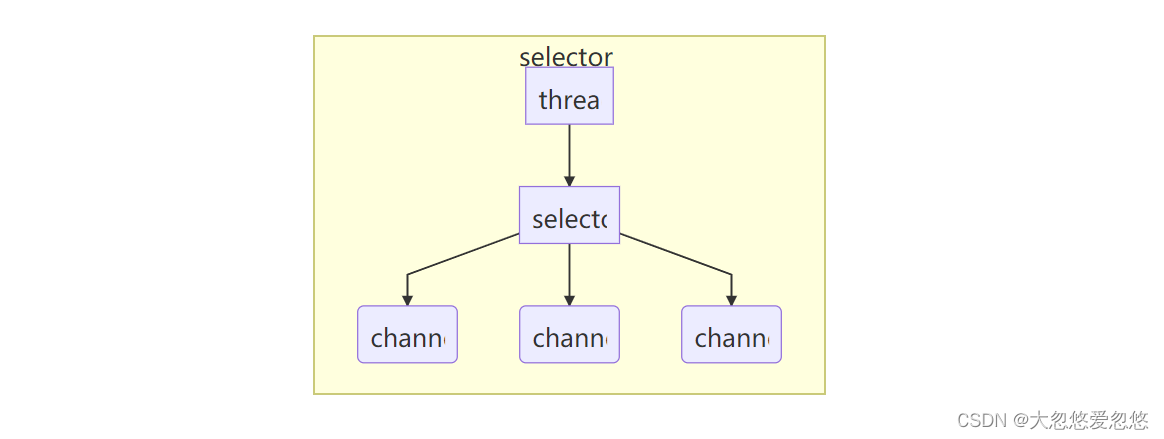
好处
- 一个线程配合 selector 就可以监控多个 channel 的事件,事件发生线程才去处理。避免非阻塞模式下所做无用功
- 让这个线程能够被充分利用
- 节约了线程的数量
- 减少了线程上下文切换
创建
Selector selector = Selector.open();
绑定 Channel 事件
也称之为注册事件,绑定的事件 selector 才会关心
channel.configureBlocking(false);
SelectionKey key = channel.register(selector, 绑定事件);
- channel 必须工作在非阻塞模式
FileChannel 没有非阻塞模式,因此不能配合 selector 一起使用- 绑定的事件类型可以有
- connect - 客户端连接成功时触发
- accept - 服务器端成功接受连接时触发
- read - 数据可读入时触发,有因为接收能力弱,数据暂不能读入的情况,另一端断开连接和发生错误的时候也会触发
- write - 数据可写出时触发,有因为发送能力弱,数据暂不能写出的情况,另一端断开连接和发生错误的时候也会触发
监听 Channel 事件
可以通过下面三种方法来监听是否有事件发生,方法的返回值代表有多少 channel 发生了事件
方法1,阻塞直到绑定事件发生
int count = selector.select();
方法2,阻塞直到绑定事件发生,或是超时(时间单位为 ms)
int count = selector.select(long timeout);
方法3,不会阻塞,也就是不管有没有事件,立刻返回,自己根据返回值检查是否有事件
int count = selector.selectNow();
select 何时不阻塞
- 事件发生时
- 客户端发起连接请求,会触发 accept 事件
客户端发送数据过来,客户端正常、异常关闭时,都会触发 read 事件,另外如果发送的数据大于 buffer 缓冲区,会触发多次读取事件- channel 可写,会触发 write 事件
- 在 linux 下 nio bug 发生时
- 调用 selector.wakeup()
- 调用 selector.close()
selector 所在线程 interrupt
4.3 处理 accept 事件
客户端代码为
public class Client {
public static void main(String[] args) {
try (Socket socket = new Socket("localhost", 19999)) {
System.out.println(socket);
socket.getOutputStream().write("world".getBytes());
//以控制台的输入数据作为输入流的来源,每次读取一个字节的数据
//可以通过返回值强转char,得到读取的字节内容
//这里为了阻塞当前客户端,不让其断开连接
System.in.read();
} catch (IOException e) {
e.printStackTrace();
}
}
}
服务器端代码为
@Slf4j
public class ChannelDemo6 {
public static void main(String[] args) {
try (ServerSocketChannel channel = ServerSocketChannel.open()) {
//绑定端口
channel.bind(new InetSocketAddress(19999));
System.out.println(channel);
//创建选择器
Selector selector = Selector.open();
//设置通道为非阻塞
channel.configureBlocking(false);
//当前通道注册到选择器上,监听客户端连接事件
channel.register(selector, SelectionKey.OP_ACCEPT);
while (true) {
//阻塞住
int count = selector.select();
// int count = selector.selectNow();
log.debug("select count: {}", count);
// if(count <= 0) {
// continue;
// }
// 获取所有事件
Set<SelectionKey> keys = selector.selectedKeys();
// 遍历所有事件,逐一处理
Iterator<SelectionKey> iter = keys.iterator();
while (iter.hasNext()) {
SelectionKey key = iter.next();
// 判断事件类型
//如果是客户端连接事件
if (key.isAcceptable()) {
ServerSocketChannel c = (ServerSocketChannel) key.channel();
// 必须处理
SocketChannel sc = c.accept();
log.debug("{}", sc);
}
// 处理完毕,必须将事件移除
iter.remove();
}
}
} catch (IOException e) {
e.printStackTrace();
}
}
}
事件发生后能否不处理
事件发生后,要么处理(处理完对应事件后,从准备好的SelectionKey 集合中移除对应的处理完的SelectionKey ),要么取消(cancel),不能什么都不做,否则下次该事件仍会触发,这是因为 nio 底层使用的是水平触发
select方法在有事件未处理时,不会阻塞
iter.remove();作用图解

每个Selector对象都需要维护以下三个集合:
1.已注册的键的集合,keys()方法返回这个已注册的键的集合,这个集合不能修改
2.已选择的键的集合,selectedKeys()方法返回,该集合中的每个成员都是相关的通道被选择器判断已经准备好的,并且包含了键的interest集合中的操作,键可以从集合中移除,不能添加.
3.已取消的键的集合,这个集合包含了调用过cancel()方法的键
上面没有画出已取消键的集合



4.4 处理 read 事件
@Slf4j
public class ChannelDemo6 {
public static void main(String[] args) {
try (ServerSocketChannel channel = ServerSocketChannel.open()) {
channel.bind(new InetSocketAddress(8080));
System.out.println(channel);
Selector selector = Selector.open();
channel.configureBlocking(false);
channel.register(selector, SelectionKey.OP_ACCEPT);
while (true) {
int count = selector.select();
// int count = selector.selectNow();
log.debug("select count: {}", count);
// if(count <= 0) {
// continue;
// }
// 获取所有事件
Set<SelectionKey> keys = selector.selectedKeys();
// 遍历所有事件,逐一处理
Iterator<SelectionKey> iter = keys.iterator();
while (iter.hasNext()) {
SelectionKey key = iter.next();
// 判断事件类型
if (key.isAcceptable()) {
ServerSocketChannel c = (ServerSocketChannel) key.channel();
// 必须处理
SocketChannel sc = c.accept();
sc.configureBlocking(false);
sc.register(selector, SelectionKey.OP_READ);
log.debug("连接已建立: {}", sc);
}
else if (key.isReadable())
{
SocketChannel sc = null;
try {
sc= (SocketChannel) key.channel();
ByteBuffer buffer = ByteBuffer.allocate(128);
int read = sc.read(buffer);
//客户端正常关闭连接
if(read == -1) {
key.cancel();
sc.close();
}
else {
buffer.flip();
debugAll(buffer);
}
} catch (IOException e) {
//客户端非正常断开连接
sc.close();
key.cancel();
}
}
// 处理完毕,必须将事件移除
iter.remove();
}
}
} catch (IOException e)
{
e.printStackTrace();
}
}
}
开启两个客户端,修改一下发送文字,输出
sun.nio.ch.ServerSocketChannelImpl[/0:0:0:0:0:0:0:0:8080]
21:16:39 [DEBUG] [main] c.i.n.ChannelDemo6 - select count: 1
21:16:39 [DEBUG] [main] c.i.n.ChannelDemo6 - 连接已建立: java.nio.channels.SocketChannel[connected local=/127.0.0.1:8080 remote=/127.0.0.1:60367]
21:16:39 [DEBUG] [main] c.i.n.ChannelDemo6 - select count: 1
+-------------------------------------------------+
| 0 1 2 3 4 5 6 7 8 9 a b c d e f |
+--------+-------------------------------------------------+----------------+
|00000000| 68 65 6c 6c 6f |hello |
+--------+-------------------------------------------------+----------------+
21:16:59 [DEBUG] [main] c.i.n.ChannelDemo6 - select count: 1
21:16:59 [DEBUG] [main] c.i.n.ChannelDemo6 - 连接已建立: java.nio.channels.SocketChannel[connected local=/127.0.0.1:8080 remote=/127.0.0.1:60378]
21:16:59 [DEBUG] [main] c.i.n.ChannelDemo6 - select count: 1
+-------------------------------------------------+
| 0 1 2 3 4 5 6 7 8 9 a b c d e f |
+--------+-------------------------------------------------+----------------+
|00000000| 77 6f 72 6c 64 |world |
+--------+-------------------------------------------------+----------------+
为何要 iter.remove()
因为 select 在事件发生后,就会将相关的 key 放入 selectedKeys 集合,但不会在处理完后从 selectedKeys 集合中移除,需要我们自己编码删除。例如
- 第一次触发了 ssckey 上的 accept 事件,没有移除 ssckey
- 第二次触发了 sckey 上的 read 事件,但这时 selectedKeys 中还有上次的 ssckey ,在处理时因为没有真正的 serverSocket 连上了,就会导致空指针异常
cancel 的作用
cancel 会取消注册在 selector 上的 channel,并从 keys 集合中删除 key 后续不会再监听事件
注意:cancel是将当前selectionkey添加进cancelKeys的集合,然后每一次调用select方法的时候,都会检查已取消的键的集合,如果该集合非空,就把该集合中的键从另外两个集合中移除,注销相关的通道,这个步骤结束后,已取消的集合应该是空的
客户端正常和异常关闭都会触发服务端的read事件
为了处理,我们需要对异常关闭try…catch捕获后,在catch块中调用key.cancel();,从 keys 集合中删除 key 后续不会再监听事件
对于正常关闭的客户端,我们只需要判断int read = sc.read(buffer);的返回结果是否是-1即可,如果是调用key.cancel();,从 keys 集合中删除 key 后续不会再监听事件
️ 不处理边界的问题
以前有同学写过这样的代码,思考注释中两个问题,以 bio 为例,其实 nio 道理是一样的
public class Server {
public static void main(String[] args) throws IOException {
ServerSocket ss=new ServerSocket(9000);
while (true) {
Socket s = ss.accept();
InputStream in = s.getInputStream();
// 这里这么写,有没有问题
byte[] arr = new byte[4];
while(true) {
int read = in.read(arr);
// 这里这么写,有没有问题
if(read == -1) {
break;
}
System.out.println(new String(arr, 0, read));
}
}
}
}
客户端
public class Client {
public static void main(String[] args) throws IOException {
Socket max = new Socket("localhost", 9000);
OutputStream out = max.getOutputStream();
out.write("hello".getBytes());
out.write("world".getBytes());
out.write("你好".getBytes());
max.close();
}
}
输出
hell
owor
ld�
�好
为什么?
处理消息的边界
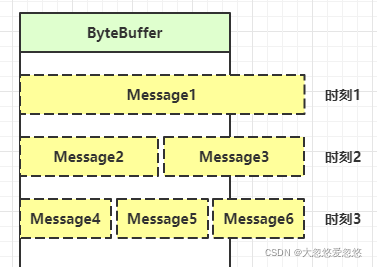
-
一种思路是固定消息长度,数据包大小一样,服务器按预定长度读取,缺点是浪费带宽

-
另一种思路是按分隔符拆分,缺点是效率低

- TLV 格式,即 Type 类型、Length 长度、Value 数据,类型和长度已知的情况下,就可以方便获取消息大小,分配合适的 buffer,缺点是 buffer 需要提前分配,如果内容过大,则影响 server 吞吐量
- Http 1.1 是 TLV 格式
- Http 2.0 是 LTV 格式

这里先采用按分隔符分割的方法来解决消息边界的问题:

服务器端
这里用到了一开始解决黏包和半包问题的split方法
/**
* @author 大忽悠
* @create 2022/1/16 22:05
*/
@Slf4j
public class Main
{
private static void split(ByteBuffer source)
{
//切换读写模式
source.flip();
for (int i = 0; i < source.limit(); i++) {
// 找到一条完整消息---get(i)不会移动position指针的位置
if (source.get(i) == '\n')
{
//计算当前消息一共多少个字节
int length = i + 1 - source.position();
// 把这条完整消息存入新的ByteBuffer---分配缓冲区大小
ByteBuffer target = ByteBuffer.allocate(length);
// 从 source 读,向 target 写--一共读取lengt个字节数据
for (int j = 0; j < length; j++) {
//不断移动position指针来读取,然后放入缓冲区中
target.put(source.get());
}
//打印当前缓冲区的信息
debugAll(target);
}
}
//将没有读取完的字节数据,移动到缓冲区的头部
source.compact(); // 0123456789abcdef position 16 limit 16
}
public static void main(String[] args) throws IOException {
// 1. 创建 selector, 管理多个 channel
Selector selector = Selector.open();
ServerSocketChannel ssc = ServerSocketChannel.open();
ssc.configureBlocking(false);
// 2. 建立 selector 和 channel 的联系(注册)
// SelectionKey 就是将来事件发生后,通过它可以知道事件和哪个channel的事件
SelectionKey sscKey = ssc.register(selector, 0, null);
// key 只关注 accept 事件
sscKey.interestOps(SelectionKey.OP_ACCEPT);
log.debug("sscKey:{}", sscKey);
ssc.bind(new InetSocketAddress(8080));
while (true) {
// 3. select 方法, 没有事件发生,线程阻塞,有事件,线程才会恢复运行
// select 在事件未处理时,它不会阻塞, 事件发生后要么处理,要么取消,不能置之不理
selector.select();
// 4. 处理事件, selectedKeys 内部包含了所有发生的事件
Iterator<SelectionKey> iter = selector.selectedKeys().iterator(); // accept, read
while (iter.hasNext()) {
SelectionKey key = iter.next();
// 处理key 时,要从 selectedKeys 集合中删除,否则下次处理就会有问题
iter.remove();
log.debug("key: {}", key);
// 5. 区分事件类型
if (key.isAcceptable()) {
// 如果是 accept
ServerSocketChannel channel = (ServerSocketChannel) key.channel();
SocketChannel sc = channel.accept();
sc.configureBlocking(false);
ByteBuffer buffer = ByteBuffer.allocate(16); // attachment
// 将一个 byteBuffer 作为附件关联到 selectionKey 上
SelectionKey scKey = sc.register(selector, 0, buffer);
scKey.interestOps(SelectionKey.OP_READ);
log.debug("{}", sc);
log.debug("scKey:{}", scKey);
} else if (key.isReadable()) {
// 如果是 read
try {
SocketChannel channel = (SocketChannel) key.channel(); // 拿到触发事件的channel
// 获取 selectionKey 上关联的附件
ByteBuffer buffer = (ByteBuffer) key.attachment();
int read = channel.read(buffer); // 如果是正常断开,read 的方法的返回值是 -1
if(read == -1) {
key.cancel();
} else {
//先读取一句话,读到换行符结束,然后打印
split(buffer);
// 需要扩容
if (buffer.position() == buffer.limit()) {
ByteBuffer newBuffer = ByteBuffer.allocate(buffer.capacity() * 2);
buffer.flip();
newBuffer.put(buffer); // 0123456789abcdef3333\n
key.attach(newBuffer);
}
}
} catch (IOException e) {
e.printStackTrace();
key.cancel(); // 因为客户端断开了,因此需要将 key 取消(从 selector 的 keys 集合中真正删除 key)
}
}
}
}
}
}
客户端
SocketChannel sc = SocketChannel.open();
sc.connect(new InetSocketAddress("localhost", 8080));
SocketAddress address = sc.getLocalAddress();
// sc.write(Charset.defaultCharset().encode("hello\nworld\n"));
sc.write(Charset.defaultCharset().encode("0123\n456789abcdef"));
sc.write(Charset.defaultCharset().encode("0123456789abcdef3333\n"));
System.in.read();
ByteBuffer 大小分配
- 每个 channel 都需要记录可能被切分的消息,因为 ByteBuffer 不能被多个 channel 共同使用,因此需要为每个 channel 维护一个独立的 ByteBuffer
// 将一个 byteBuffer 作为附件关联到 selectionKey 上
SelectionKey scKey = sc.register(selector, 0, buffer);
//更新附加为扩容后的缓冲区大小
key.attach(newBuffer);
- ByteBuffer 不能太大,比如一个 ByteBuffer 1Mb 的话,要支持百万连接就要 1Tb 内存,因此需要设计大小可变的 ByteBuffer
- 一种思路是首先分配一个较小的 buffer,例如 4k,如果发现数据不够,再分配 8k 的 buffer,将 4k buffer 内容拷贝至 8k buffer,优点是消息连续容易处理,缺点是数据拷贝耗费性能,参考实现 http://tutorials.jenkov.com/java-performance/resizable-array.html
- 另一种思路是用多个数组组成 buffer,一个数组不够,把多出来的内容写入新的数组,与前面的区别是消息存储不连续解析复杂,优点是避免了拷贝引起的性能损耗
4.5 处理 write 事件
客户端:
/**
* @author 大忽悠
*/
public class WriteClient {
private static Selector selector;
private static SocketChannel sc;
/**
* 建立与服务器的连接
*/
public static void buildConnection()
{
try {
selector = Selector.open();
sc = SocketChannel.open();
sc.configureBlocking(false);
//监听与服务器的连接建立事件和服务器发送过来的可读数据事件
sc.register(selector, SelectionKey.OP_CONNECT | SelectionKey.OP_READ);
//连接服务器
sc.connect(new InetSocketAddress("localhost", 8080));
}
catch (IOException e) {
e.printStackTrace();
}
}
public static void main(String[] args) throws IOException {
//建立连接
buildConnection();
//计算总共读取的字节数
int count = 0;
while (true) {
selector.select();
Iterator<SelectionKey> iter = selector.selectedKeys().iterator();
while (iter.hasNext()) {
SelectionKey key = iter.next();
//移除当前准备好的事件,防止重复处理
iter.remove();
if (key.isConnectable()) {
//finishConnect是否完成了连接
System.out.println(sc.finishConnect());
}
//服务器的数据可能因为数据量过大,需要分几次发送过来,那么就会产生多次的可读事件
else if (key.isReadable())
{
ByteBuffer buffer = ByteBuffer.allocate(1024 * 1024);
count += sc.read(buffer);
buffer.clear();
System.out.println(count);
}
}
}
}
}
一次无法写完例子
- 非阻塞模式下,无法保证把 buffer 中所有数据都写入 channel,因此需要追踪 write 方法的返回值(代表实际写入字节数)
服务端:
/**
* @author 大忽悠
*/
public class WriteServer {
private static ServerSocketChannel ssc;
private static Selector selector;
/**
* 建立连接
*/
public static void buildConnection()
{
try {
ssc = ServerSocketChannel.open();
ssc.configureBlocking(false);
ssc.bind(new InetSocketAddress(8080));
selector = Selector.open();
ssc.register(selector, SelectionKey.OP_ACCEPT);
} catch (IOException e) {
e.printStackTrace();
}
}
public static void main(String[] args) throws IOException
{
buildConnection();
while(true)
{
selector.select();
Iterator<SelectionKey> iter = selector.selectedKeys().iterator();
while (iter.hasNext()) {
SelectionKey key = iter.next();
//移除,防止事件被重复处理
iter.remove();
//客户端连接事件
if (key.isAcceptable())
{
SocketChannel sc = ssc.accept();
sc.configureBlocking(false);
//监听可读事件
SelectionKey sckey = sc.register(selector, SelectionKey.OP_READ);
// 1. 向客户端发送内容
StringBuilder sb = new StringBuilder();
for (int i = 0; i < 3000000; i++) {
sb.append("a");
}
//编码为ByteBuffer
ByteBuffer buffer = Charset.defaultCharset().encode(sb.toString());
//缓冲区还有数据没读取完
while(buffer.hasRemaining())
{
int write = sc.write(buffer);
System.out.println("写入的字节数: "+write);
}
}
}
}
}
}
服务器端输出:
写入的字节数: 2883562
写入的字节数: 0
写入的字节数: 0
写入的字节数: 0
写入的字节数: 0
写入的字节数: 0
写入的字节数: 0
写入的字节数: 0
写入的字节数: 0
写入的字节数: 0
写入的字节数: 0
写入的字节数: 0
写入的字节数: 0
写入的字节数: 0
写入的字节数: 0
写入的字节数: 0
写入的字节数: 0
写入的字节数: 0
写入的字节数: 0
写入的字节数: 0
写入的字节数: 0
写入的字节数: 0
写入的字节数: 0
写入的字节数: 0
写入的字节数: 0
写入的字节数: 0
写入的字节数: 0
写入的字节数: 0
写入的字节数: 0
写入的字节数: 0
写入的字节数: 0
写入的字节数: 0
写入的字节数: 0
写入的字节数: 0
写入的字节数: 0
写入的字节数: 0
写入的字节数: 0
写入的字节数: 0
写入的字节数: 0
写入的字节数: 0
写入的字节数: 0
写入的字节数: 0
写入的字节数: 0
写入的字节数: 0
写入的字节数: 0
写入的字节数: 0
写入的字节数: 0
写入的字节数: 0
写入的字节数: 0
写入的字节数: 0
写入的字节数: 0
写入的字节数: 0
写入的字节数: 0
写入的字节数: 0
写入的字节数: 0
写入的字节数: 0
写入的字节数: 0
写入的字节数: 0
写入的字节数: 0
写入的字节数: 0
写入的字节数: 0
写入的字节数: 0
写入的字节数: 0
写入的字节数: 0
写入的字节数: 0
写入的字节数: 0
写入的字节数: 0
写入的字节数: 0
写入的字节数: 0
写入的字节数: 0
写入的字节数: 0
写入的字节数: 0
写入的字节数: 0
写入的字节数: 0
写入的字节数: 0
写入的字节数: 0
写入的字节数: 0
写入的字节数: 0
写入的字节数: 0
写入的字节数: 0
写入的字节数: 0
写入的字节数: 0
写入的字节数: 0
写入的字节数: 0
写入的字节数: 0
写入的字节数: 0
写入的字节数: 0
写入的字节数: 0
写入的字节数: 0
写入的字节数: 0
写入的字节数: 0
写入的字节数: 0
写入的字节数: 0
写入的字节数: 0
写入的字节数: 0
写入的字节数: 0
写入的字节数: 0
写入的字节数: 0
写入的字节数: 0
写入的字节数: 0
写入的字节数: 0
写入的字节数: 0
写入的字节数: 0
写入的字节数: 0
写入的字节数: 0
写入的字节数: 0
写入的字节数: 0
写入的字节数: 0
写入的字节数: 0
写入的字节数: 0
写入的字节数: 0
写入的字节数: 0
写入的字节数: 0
写入的字节数: 0
写入的字节数: 0
写入的字节数: 0
写入的字节数: 0
写入的字节数: 0
写入的字节数: 0
写入的字节数: 0
写入的字节数: 0
写入的字节数: 0
写入的字节数: 0
写入的字节数: 0
写入的字节数: 0
写入的字节数: 0
写入的字节数: 0
写入的字节数: 0
写入的字节数: 0
写入的字节数: 0
写入的字节数: 0
写入的字节数: 0
写入的字节数: 0
写入的字节数: 0
写入的字节数: 0
写入的字节数: 0
写入的字节数: 0
写入的字节数: 0
写入的字节数: 0
写入的字节数: 0
写入的字节数: 0
写入的字节数: 0
写入的字节数: 0
写入的字节数: 0
写入的字节数: 0
写入的字节数: 0
写入的字节数: 0
写入的字节数: 0
写入的字节数: 0
写入的字节数: 0
写入的字节数: 0
写入的字节数: 0
写入的字节数: 0
写入的字节数: 0
写入的字节数: 0
写入的字节数: 0
写入的字节数: 0
写入的字节数: 0
写入的字节数: 0
写入的字节数: 0
写入的字节数: 0
写入的字节数: 0
写入的字节数: 0
写入的字节数: 0
写入的字节数: 0
写入的字节数: 0
写入的字节数: 0
写入的字节数: 0
写入的字节数: 0
写入的字节数: 0
写入的字节数: 0
写入的字节数: 0
写入的字节数: 0
写入的字节数: 0
写入的字节数: 0
写入的字节数: 0
写入的字节数: 0
写入的字节数: 0
写入的字节数: 0
写入的字节数: 0
写入的字节数: 0
写入的字节数: 0
写入的字节数: 0
写入的字节数: 0
写入的字节数: 0
写入的字节数: 0
写入的字节数: 0
写入的字节数: 0
写入的字节数: 0
写入的字节数: 0
写入的字节数: 0
写入的字节数: 0
写入的字节数: 0
写入的字节数: 0
写入的字节数: 0
写入的字节数: 0
写入的字节数: 0
写入的字节数: 0
写入的字节数: 0
写入的字节数: 0
写入的字节数: 0
写入的字节数: 0
写入的字节数: 0
写入的字节数: 0
写入的字节数: 0
写入的字节数: 0
写入的字节数: 0
写入的字节数: 0
写入的字节数: 0
写入的字节数: 0
写入的字节数: 0
写入的字节数: 0
写入的字节数: 0
写入的字节数: 0
写入的字节数: 0
写入的字节数: 116438
客户端输出:
true
131071
262142
393213
524284
655355
786426
917497
1048568
1179639
1310710
1441781
1572852
1703923
1834994
1966065
2097136
2228207
2359278
2490349
2621420
2752491
2883562
3000000
从上面可以看出几点:
- 服务器这边,通道的write先会将数据先写入缓冲区,但是缓冲区大小不固定,有上限,因此数据没办法一次性写完,需要分很多次写入,并且过程中如果缓冲区写满了,并且数据还没发送完,服务器会在尝试很多次的情况下依然写入失败,只有等待缓冲区数据发送完了,服务器才能再往里面写数据,这样过程中尝试很多次的次数,就非常的浪费性能
- 客户端这边,服务器从操作系统底层缓冲区读取数据发送给客户端,也不是一次性就可以全部把缓冲区数据发送完毕的,需要分多次发送,才能发完,这样就会触发很多次的可读事件
- 还有一个就是服务器这边在尝试的过程不仅浪费了时间,还阻塞了当前线程的执行,让其他触发的事件得不到及时的处理,会越累积越多
- 用 selector 监听所有 channel 的可写事件,每个 channel 都需要一个 key 来跟踪 buffer,但这样又会导致占用内存过多,就有两阶段策略
- 当消息处理器第一次写入消息时,才将 channel 注册到 selector 上
- selector 检查 channel 上的可写事件,如果所有的数据写完了,就取消 channel 的注册
- 如果不取消,会每次可写均会触发 write 事件
- 这里可写事件的触发指的就是发送缓冲区空了,可以写入数据了,就会触发可写事件,可以对应看上面尝试写入的过程,就是发送缓冲区满了,写不了数据,而可以成功写入数据,就是可写缓冲区空了
改进后的服务器端:
/**
* @author 大忽悠
*/
public class WriteServer {
private static ServerSocketChannel ssc;
private static Selector selector;
/**
* 建立连接
*/
public static void buildConnection()
{
try {
ssc = ServerSocketChannel.open();
ssc.configureBlocking(false);
ssc.bind(new InetSocketAddress(18080));
selector = Selector.open();
ssc.register(selector, SelectionKey.OP_ACCEPT);
} catch (IOException e) {
e.printStackTrace();
}
}
public static void main(String[] args) throws IOException
{
buildConnection();
while(true)
{
selector.select();
Iterator<SelectionKey> iter = selector.selectedKeys().iterator();
while (iter.hasNext()) {
SelectionKey key = iter.next();
//移除,防止事件被重复处理
iter.remove();
//客户端连接事件
if (key.isAcceptable()) {
SocketChannel sc = ssc.accept();
sc.configureBlocking(false);
SelectionKey sckey = sc.register(selector, SelectionKey.OP_READ);
// 1. 向客户端发送内容
StringBuilder sb = new StringBuilder();
for (int i = 0; i < 3000000; i++) {
sb.append("a");
}
ByteBuffer buffer = Charset.defaultCharset().encode(sb.toString());
int write = sc.write(buffer);
// 3. write 表示实际写了多少字节
System.out.println("实际写入字节:" + write);
// 4. 如果有剩余未读字节,才需要关注写事件
if (buffer.hasRemaining()) {
// read 1 write 4
// 在原有关注事件的基础上,多关注 写事件
sckey.interestOps(sckey.interestOps() + SelectionKey.OP_WRITE);
// 把 buffer 作为附件加入 sckey
sckey.attach(buffer);
}
}
//关注写事件,如果缓冲区还有数据没有写完,就会触发该事件
else if (key.isWritable()) {
ByteBuffer buffer = (ByteBuffer) key.attachment();
SocketChannel sc = (SocketChannel) key.channel();
int write = sc.write(buffer);
System.out.println("实际写入字节:" + write);
if (!buffer.hasRemaining()) {
// 写完了
key.interestOps(key.interestOps() - SelectionKey.OP_WRITE);
key.attach(null);
}
}
}
}
}
}
服务器:
实际写入字节:4849627
实际写入字节:3014633
实际写入字节:3145704
实际写入字节:11009964
实际写入字节:4718556
实际写入字节:2490349
实际写入字节:771167
客户端:
true
131071
262142
393213
524284
...
29817802
29948873
30000000
总结
为何注册写事件,何时注册写事件,为什么写完之后要取消注册写事件。
如果有channel在Selector上注册了SelectionKey.OP_WRITE事件,在调用selector.select();时,系统会检查内核写缓冲区是否可写(什么时候是不可写的呢,比如缓冲区已满,channel调用了shutdownOutPut等等),如果可写,selector.select();立即返回,随后进入key.isWritable()分支。
当然你在channel上可以直接调用write(…),也可以将数据发送出去,但这样不够灵活,而且可能浪费CPU。
//不使用事件,缺点是,程序运行到这会等到200M文件发送完成后才继续往下执行,不符合异步事件模型
//的编程思想,如果缓冲区一直处于不可写状态,那么该过程一直在这里死循环,浪费了CPU资源。
ByteBuffer buffer = .... //200M的Buffer
while(buffer.hasRemaining()) {
//该方法只会写入小于socket's output buffer空闲区域的任何字节数
//并返回写入的字节数,可能是0字节。
channel.write(buffer);
}
//使用事件的方式,谁好谁坏,一看便知
if(key.isReadable()) {
ByteBuffer buffer = .... //200M的Buffer
//注册写事件
key.interestOps(key.interestOps() | SelectionKey.OP_WRITE);
//绑定Buffer
key.attach(buffer);
}
//isWritable分支
if(key.isWritable()) {
ByteBuffer buffer = (ByteBuffer) key.attachment();
SocketChannel channel = (SocketChannel) key.channel();
if (buffer.hasRemaining()) {
channel.write(buffer)
} else {
key.attach(null);
//发送完了就取消写事件,否则下次还会进入该分支
key.interestOps(key.interestOps() & ~SelectionKey.OP_WRITE);
}
}
注:write事件除了用上面的方法key.attach(buffer)带buffer内容给handler外,还可以直接在用channel.register方法的第三个参数attach携带要写的内容。当注册了写事件,并携带了要写的内容后,会在可写事件发生被select出来时,通过key.attachment()拿出携带的要写的内容,进行写处理。
客户端开发的一般步骤:
//打开选择器
Selector selector = Selector.open();
//打开通道
SocketChannel socketChannel = SocketChannel.open();
//配置非阻塞模型
socketChannel.configureBlocking(false);
//连接远程主机
socketChannel.connect(new InetSocketAddress("127.0.0.1",8080));
//注册事件
socketChannel.register(selector, SelectionKey.OP_CONNECT | SelectionKey.OP_READ);
//循环处理
while (true) {
selector.select();
Set<SelectionKey> keys = selector.selectedKeys();
Iterator<SelectionKey> iter = keys.iterator();
while(iter.hasNext()) {
SelectionKey key = iter.next();
if(key.isConnectable()) {
//连接建立或者连接建立不成功
SocketChannel channel = (SocketChannel) key.channel();
//完成连接的建立
if(channel.finishConnect()) {
}
}
if(key.isReadable()) {
SocketChannel channel = (SocketChannel) key.channel();
ByteBuffer buffer = ByteBuffer.allocate(500 * 1024 * 1024);
buffer.clear();
channel.read(buffer);
//buffer Handler
}
iter.remove();
}
}
起初对OP_CONNECT事件还有finishConnect不理解,OP_CONNECT事件何时触发,特别是为什么要在key.isConnectable()分支里调用finishConnect方法后才能进行读写操作。
首先,在non-blocking模式下调用socketChannel.connect(new InetSocketAddress(“127.0.0.1”,8080));连接远程主机,如果连接能立即建立就像本地连接一样,该方法会立即返回true,否则该方法会立即返回false,然后系统底层进行三次握手建立连接。
连接有两种结果,一种是成功连接,第二种是异常,但是connect方法已经返回,无法通过该方法的返回值或者是异常来通知用户程序建立连接的情况,所以由OP_CONNECT事件和finishConnect方法来通知用户程序。
不管系统底层三次连接是否成功,selector都会被唤醒继而触发OP_CONNECT事件,如果握手成功,并且该连接未被其他线程关闭,finishConnect会返回true,然后就可以顺利的进行channle读写。如果网络故障,或者远程主机故障,握手不成功,用户程序可以通过finishConnect方法获得底层的异常通知,进而处理异常。
4.6 更进一步
利用多线程优化
现在都是多核 cpu,设计时要充分考虑别让 cpu 的力量被白白浪费
前面的代码只有一个选择器,没有充分利用多核 cpu,如何改进呢?
分两组选择器
- 单线程配一个选择器,专门处理 accept 事件
- 创建 cpu 核心数的线程,每个线程配一个选择器,轮流处理 read 事件
旧模式:

新模式

从上图可以看出,Boss线程只负责建立客户端连接,建立后,由工作线程来处理客户端的数据读写事件的监听
工作线程的数量一般控制在cpu核心数大小左右,并且每个工作线程对应一个Selector,负责监听注册在自己选择器上面的所有客户端的读写事件
写代码前,需要注意下面几点:
- nio的select()方法和register()方法执行,底层会用到同一把锁,因此如果select先执行并且阻塞住了,就无法释放锁,register方法就会因为获取不到锁而阻塞住


- 两个线程之间需要完成通信的话,一般通过线程安全的队列实现,这里采用的是ConcurrentLinkedQueue
服务端代码实现:
import lombok.extern.slf4j.Slf4j;
import java.io.IOException;
import java.net.InetSocketAddress;
import java.nio.ByteBuffer;
import java.nio.channels.SelectionKey;
import java.nio.channels.Selector;
import java.nio.channels.ServerSocketChannel;
import java.nio.channels.SocketChannel;
import java.util.Iterator;
import java.util.Set;
import java.util.concurrent.ConcurrentLinkedQueue;
import java.util.concurrent.atomic.AtomicInteger;
import static dhy.com.ByteBufferUtil.debugAll;
/**
* @author DHY
*/
public class ChannelDemo7
{
public static void main(String[] args) throws IOException
{
//启动Boss线程接收客户端的连接
new BossEventLoop().register();
}
@Slf4j
static class BossEventLoop implements Runnable
{
/**
* boss线程选择器,用于接收客户端的连接
*/
private Selector boss;
/**
* 工作线程
*/
private WorkerEventLoop[] workers;
/**
* 服务端Boss线程是否启动
*/
private volatile boolean start = false;
/**
* 轮询计数
*/
AtomicInteger index = new AtomicInteger();
public void register() throws IOException
{
//防止服务端重复启动
if (!start)
{
//创建一个ServerSocketChannel通道
ServerSocketChannel ssc = ServerSocketChannel.open();
//绑定端口
ssc.bind(new InetSocketAddress(8080));
//设置为非阻塞
ssc.configureBlocking(false);
//创建选择器
boss = Selector.open();
//当前ServerSocketChannel通道注册到Boss选择器上
SelectionKey ssckey = ssc.register(boss, 0, null);
//服务端通道用来接收客户端的连接
ssckey.interestOps(SelectionKey.OP_ACCEPT);
//初始化工作线程
workers = initEventLoops();
//启动Boss线程,来接收客户端的连接请求
new Thread(this, "boss").start();
log.debug("boss start...");
//请求成功,设置标记
start = true;
}
}
public WorkerEventLoop[] initEventLoops() {
//可以通过api来获取系统核心线程数,将工作线程大小设置为核心线程数量
// EventLoop[] eventLoops = new EventLoop[Runtime.getRuntime().availableProcessors()];
//由于上面api存在一定的bug,因此下面手动设置工作线程数量
WorkerEventLoop[] workerEventLoops = new WorkerEventLoop[2];
//初始化工作线程
for (int i = 0; i < workerEventLoops.length; i++) {
workerEventLoops[i] = new WorkerEventLoop(i);
}
return workerEventLoops;
}
@Override
public void run() {
while (true) {
try {
//Boss选择器阻塞接收客户端连接请求
boss.select();
Iterator<SelectionKey> iter = boss.selectedKeys().iterator();
while (iter.hasNext())
{
SelectionKey key = iter.next();
//将处理完的事件移除,防止死循环产生
iter.remove();
//客户端连接事件
if (key.isAcceptable())
{
//接收客户端的连接
ServerSocketChannel c = (ServerSocketChannel) key.channel();
SocketChannel sc = c.accept();
//设置客户端为非阻塞模式
sc.configureBlocking(false);
log.debug("{} connected", sc.getRemoteAddress());
//这里采用轮询的方式,让每个工作线程挨个处理客户端的读写请求
workers[index.getAndIncrement() % workers.length].register(sc);
}
}
} catch (IOException e) {
e.printStackTrace();
}
}
}
}
@Slf4j
static class WorkerEventLoop implements Runnable {
/**
* 工作线程的选择器,负责监听客户端的读写事件
*/
private Selector worker;
/**
* 工作线程是否已经启动
*/
private volatile boolean start = false;
/**
* 工作线程的序号
*/
private int index;
/**
* 任务队列,用于在多线程间进行安全通信
*/
private final ConcurrentLinkedQueue<Runnable> tasks = new ConcurrentLinkedQueue<>();
public WorkerEventLoop(int index) {
this.index = index;
}
/**
* @param sc Boss选择器监听到客户端连接事件后,会把客户端对象传入,让当前工作线程监听其后续的读写事件并做处理
* @throws IOException
*/
public void register(SocketChannel sc) throws IOException
{
//TODO:这里存在select方法和register方法执行先后顺序的问题
//如果当前工作线程还没有初始化,就进行初始化操作
if (!start) {
//创建选择器
worker = Selector.open();
//启动工作线程---这里存在select先执行还是register先执行的问题
new Thread(this, "worker-" + index).start();
//设置标记
start = true;
}
//添加任务对队列---为了解决上述问题
tasks.add(() ->
{
try {
//当前客户端注册进工作线程的选择器中
SelectionKey sckey = sc.register(worker, 0, null);
//监听感兴趣的事件
sckey.interestOps(SelectionKey.OP_READ);
//不管有没有事件,立刻返回,可以根据返回值进行判断
worker.selectNow();
} catch (IOException e) {
e.printStackTrace();
}
});
//唤醒select阻塞住的线程---为了解决上述问题
worker.wakeup();
}
@Override
public void run() {
while (true) {
try {
//监听事件
worker.select();
//获取队列头部的任务,如果没有任务,返回null
Runnable task = tasks.poll();
//如果任务存在,执行任务
//这里因为select方法先执行,因此执行的任务里面才有register---->selectNow
if (task != null) {
task.run();
}
Set<SelectionKey> keys = worker.selectedKeys();
Iterator<SelectionKey> iter = keys.iterator();
while (iter.hasNext()) {
SelectionKey key = iter.next();
//可读事件
if (key.isReadable()) {
SocketChannel sc = (SocketChannel) key.channel();
ByteBuffer buffer = ByteBuffer.allocate(128);
try {
int read = sc.read(buffer);
//客户端正常关闭
if (read == -1) {
//取消当前客户端通道的注册
key.cancel();
sc.close();
}
else {
buffer.flip();
log.debug("{} message:", sc.getRemoteAddress());
debugAll(buffer);
}
} catch (IOException e) {
e.printStackTrace();
//客户端异常关闭
key.cancel();
sc.close();
}
}
//移除处理完后的事件
iter.remove();
}
} catch (IOException e) {
e.printStackTrace();
}
}
}
}
}
如何拿到 cpu 个数
- Runtime.getRuntime().availableProcessors() 如果工作在 docker 容器下,因为容器不是物理隔离的,会拿到物理 cpu 个数,而不是容器申请时的个数
- 这个问题直到 jdk 10 才修复,使用 jvm 参数 UseContainerSupport 配置, 默认开启
wakeup底层实现
NIO中的Selector封装了底层的系统调用,其中wakeup用于唤醒阻塞在select方法上的线程,它的实现很简单,在linux上就是创建一 个管道并加入poll的fd集合,wakeup就是往管道里写一个字节,那么阻塞的poll方法有数据可读就立即返回。
wakeup方法的API还告诉我们,如果当前Selector没有阻塞在select方法上,那么本次 wakeup调用会在下一次select阻塞的时候生效,这个道理很简单,wakeup方法写入一个字节,下次poll等待的时候立即发现可读并返回,因 此不会阻塞。
4.7 UDP
- UDP 是无连接的,client 发送数据不会管 server 是否开启
- server 这边的 receive 方法会将接收到的数据存入 byte buffer,但如果数据报文超过 buffer 大小,多出来的数据会被默默抛弃
首先启动服务器端
public class UdpServer {
public static void main(String[] args) {
try (DatagramChannel channel = DatagramChannel.open()) {
channel.socket().bind(new InetSocketAddress(9999));
System.out.println("waiting...");
ByteBuffer buffer = ByteBuffer.allocate(32);
channel.receive(buffer);
buffer.flip();
debug(buffer);
} catch (IOException e) {
e.printStackTrace();
}
}
}
输出
waiting...
运行客户端
public class UdpClient {
public static void main(String[] args) {
try (DatagramChannel channel = DatagramChannel.open()) {
ByteBuffer buffer = StandardCharsets.UTF_8.encode("hello");
InetSocketAddress address = new InetSocketAddress("localhost", 9999);
channel.send(buffer, address);
} catch (Exception e) {
e.printStackTrace();
}
}
}
接下来服务器端输出
+-------------------------------------------------+
| 0 1 2 3 4 5 6 7 8 9 a b c d e f |
+--------+-------------------------------------------------+----------------+
|00000000| 68 65 6c 6c 6f |hello |
+--------+-------------------------------------------------+----------------+
5. NIO vs BIO
5.1 stream vs channel
- stream 不会自动缓冲数据,channel 会利用系统提供的发送缓冲区、接收缓冲区(更为底层)
- stream 仅支持阻塞 API,channel 同时支持阻塞、非阻塞 API,网络 channel 可配合 selector 实现多路复用
- 二者均为全双工,即读写可以同时进行
5.2 IO 模型
同步阻塞、同步非阻塞、同步多路复用、异步阻塞(没有此情况)、异步非阻塞
- 同步:线程自己去获取结果(一个线程)
- 异步:线程自己不去获取结果,而是由其它线程送结果(至少两个线程)
当调用一次 channel.read 或 stream.read 后,会切换至操作系统内核态来完成真正数据读取,而读取又分为两个阶段,分别为:
- 等待数据阶段
- 复制数据阶段


- 阻塞 IO

用户线程调用read方法读取数据的时候,进而调用os的read方法,os发现数据还没到达,陷入等待,此时用户线程也需要陷入等待,此时不会占用cpu,这就是我们说的阻塞
- 非阻塞 IO

非阻塞指的就是用户线程调用read方法询问操作系统是否有数据的时候,如果没有数据就直接返回,不会阻塞住
非阻塞体现在等待无数据直接返回上,一旦有了数据,复制数据的过程还是会阻塞住
非阻塞IO的性能不一定就比阻塞IO好,因为非阻塞IO涉及多次用户空间和系统内核空间的切换
- 多路复用

从上图可以看出,多路复用在等待事件和复制数据的过程都需要阻塞,还比阻塞IO多了一次内核与用户空间的切换,这样一看,多路复用的性能还比较差,那么多路复用的优势体现在哪里呢?


select会得到发生的一批事件,将多个事件在select结束时,一并返回
- 信号驱动
不太常用,这里不展开
- 异步 IO
同步阻塞,同步非阻塞,多路复用都是同步的,因为都是同一个线程去要结果,同一个线程去拿回来结果
同步阻塞、同步非阻塞、同步多路复用、异步阻塞(没有此情况)、异步非阻塞
- 同步:线程自己去获取结果(一个线程)
- 异步:线程自己不去获取结果,而是由其它线程送结果(至少两个线程)
异步情况下,没有阻塞之说,异步都是非阻塞,对于异步操作来说,一般都是一个线程根操作系统打个招呼,说数据来了,麻烦送给我,然后操作系统再数据来了的时候,开辟一个线程去送数据,而最开始的线程通过回调函数可以获取到操作系统返回的数据

参考
UNIX 网络编程 - 卷 I
5.3 零拷贝
传统 IO 问题
传统的 IO 将一个文件通过 socket 写出
File f = new File("helloword/data.txt");
RandomAccessFile file = new RandomAccessFile(file, "r");
byte[] buf = new byte[(int)f.length()];
file.read(buf);
Socket socket = ...;
socket.getOutputStream().write(buf);
内部工作流程是这样的:
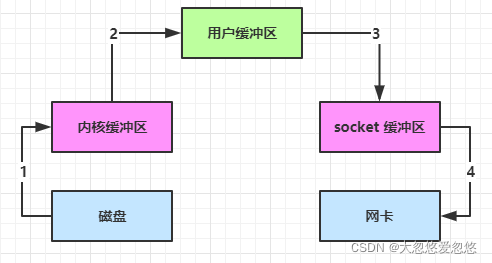
- java 本身并不具备 IO 读写能力,因此 read 方法调用后,要从 java程序的用户态切换至内核态,去调用操作系统(Kernel)的读能力,将数据读入内核缓冲区。这期间用户线程阻塞,操作系统使用 DMA(Direct Memory Access)来实现文件读,其间也不会使用 cpu
DMA 也可以理解为硬件单元,用来解放 cpu 完成文件 IO
- 从内核态切换回用户态,将数据从内核缓冲区读入用户缓冲区(即 byte[] buf),这期间 cpu 会参与拷贝,无法利用 DMA
- 调用 write 方法,这时将数据从用户缓冲区(byte[] buf)写入 socket 缓冲区,cpu 会参与拷贝
- 接下来要向网卡写数据,这项能力 java 又不具备,因此又得从用户态切换至内核态,调用操作系统的写能力,使用 DMA 将 socket 缓冲区的数据写入网卡,不会使用 cpu
可以看到中间环节较多,java 的 IO 实际不是物理设备级别的读写,而是缓存的复制,底层的真正读写是操作系统来完成的
- 用户态与内核态的切换发生了 3 次,这个操作比较重量级
- 数据拷贝了共 4 次
NIO 优化
通过 DirectByteBuf
- ByteBuffer.allocate(10) HeapByteBuffer 使用的还是 java 内存
- ByteBuffer.allocateDirect(10) DirectByteBuffer 使用的是操作系统内存

大部分步骤与优化前相同,不再赘述。唯有一点:java 可以使用 DirectByteBuf 将堆外内存映射到 jvm 内存中来直接访问使用
- 这块内存不受 jvm 垃圾回收的影响,因此内存地址固定,有助于 IO 读写
- java 中的 DirectByteBuf 对象仅维护了此内存的虚引用,内存回收分成两步
- DirectByteBuf 对象被垃圾回收,将虚引用加入引用队列
- 通过专门线程访问引用队列,根据虚引用释放堆外内存
- 减少了一次数据拷贝,用户态与内核态的切换次数没有减少
进一步优化(底层采用了 linux 2.1 后提供的 sendFile 方法),java 中对应着两个 channel 调用 transferTo/transferFrom 方法拷贝数据

- java 调用 transferTo 方法后,要从 java 程序的用户态切换至内核态,使用 DMA将数据读入内核缓冲区,不会使用 cpu
- 数据从内核缓冲区传输到 socket 缓冲区,cpu 会参与拷贝
- 最后使用 DMA 将 socket 缓冲区的数据写入网卡,不会使用 cpu
可以看到
- 只发生了一次用户态与内核态的切换
- 数据拷贝了 3 次
进一步优化(linux 2.4)
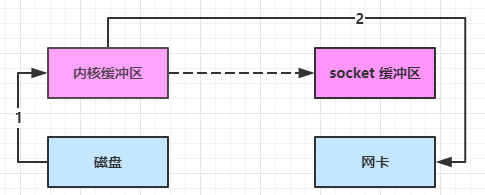
- java 调用 transferTo 方法后,要从 java 程序的用户态切换至内核态,使用 DMA将数据读入内核缓冲区,不会使用 cpu
- 只会将一些 offset 和 length 信息拷入 socket 缓冲区,几乎无消耗
- 使用 DMA 将 内核缓冲区的数据写入网卡,不会使用 cpu
整个过程仅只发生了一次用户态与内核态的切换,数据拷贝了 2 次。所谓的【零拷贝】,并不是真正无拷贝,而是在不会拷贝重复数据到 jvm 内存中,零拷贝的优点有
- 更少的用户态与内核态的切换
- 不利用 cpu 计算,减少 cpu 缓存伪共享
- 零拷贝适合小文件传输
5.3 AIO
AIO 用来解决数据复制阶段的阻塞问题
- 同步意味着,在进行读写操作时,线程需要等待结果,还是相当于闲置
- 异步意味着,在进行读写操作时,线程不必等待结果,而是将来由操作系统来通过回调方式由另外的线程来获得结果
异步模型需要底层操作系统(Kernel)提供支持
- Windows 系统通过 IOCP 实现了真正的异步 IO
- Linux 系统异步 IO 在 2.6 版本引入,但其底层实现还是用多路复用模拟了异步 IO,性能没有优势
文件 AIO
先来看看 AsynchronousFileChannel
@Slf4j
public class AioDemo1 {
public static void main(String[] args) throws IOException {
try{
AsynchronousFileChannel s =
AsynchronousFileChannel.open(
//文件路径,文件的打开方式
Paths.get("1.txt"), StandardOpenOption.READ);
ByteBuffer buffer = ByteBuffer.allocate(2);
log.debug("begin...");
//返回结果的线程是守护线程,即主线程一结束,守护线程就凉凉了
//思安个参数是附件---如果数据一次性读取不完,可以通过附件的方式,多次读取完成
s.read(buffer, 0, buffer, new CompletionHandler<Integer, ByteBuffer>() {
@Override
//读取的字节数和附件
public void completed(Integer result, ByteBuffer attachment) {
log.debug("read completed...{}", result);
attachment.flip();
debugAll(buffer);
}
@Override
public void failed(Throwable exc, ByteBuffer attachment) {
log.debug("read failed...");
}
});
} catch (IOException e) {
e.printStackTrace();
}
log.debug("do other things...");
System.in.read();
}
}
结果
16:39:01.559 [main] DEBUG dhy.com.AioDemo1 - begin...
16:39:01.563 [main] DEBUG dhy.com.AioDemo1 - do other things...
16:39:01.563 [Thread-12] DEBUG dhy.com.AioDemo1 - read completed...2
16:39:01.576 [Thread-12] DEBUG io.netty.util.internal.logging.InternalLoggerFactory - Using SLF4J as the default logging framework
+--------+-------------------- all ------------------------+----------------+
position: [0], limit: [2]
+-------------------------------------------------+
| 0 1 2 3 4 5 6 7 8 9 a b c d e f |
+--------+-------------------------------------------------+----------------+
|00000000| 64 61 |da |
+--------+-------------------------------------------------+----------------+
可以看到
- 响应文件读取成功的是另一个线程 Thread-12
- 主线程并没有 IO 操作阻塞
守护线程
默认文件 AIO 使用的线程都是守护线程,所以最后要执行 System.in.read() 以避免守护线程意外结束
网络 AIO
package dhy.com;
import java.io.IOException;
import java.net.InetSocketAddress;
import java.nio.ByteBuffer;
import java.nio.channels.AsynchronousServerSocketChannel;
import java.nio.channels.AsynchronousSocketChannel;
import java.nio.channels.CompletionHandler;
import java.nio.charset.Charset;
public class AioServer {
public static void main(String[] args) throws IOException
{
AsynchronousServerSocketChannel ssc = AsynchronousServerSocketChannel.open();
ssc.bind(new InetSocketAddress(8080));
ssc.accept(null, new AcceptHandler(ssc));
System.in.read();
}
private static void closeChannel(AsynchronousSocketChannel sc) {
try {
System.out.printf("[%s] %s close\n", Thread.currentThread().getName(), sc.getRemoteAddress());
sc.close();
} catch (IOException e) {
e.printStackTrace();
}
}
private static class ReadHandler implements CompletionHandler<Integer, ByteBuffer> {
private final AsynchronousSocketChannel sc;
public ReadHandler(AsynchronousSocketChannel sc) {
this.sc = sc;
}
@Override
public void completed(Integer result, ByteBuffer attachment) {
try {
if (result == -1) {
closeChannel(sc);
return;
}
System.out.printf("[%s] %s read\n", Thread.currentThread().getName(), sc.getRemoteAddress());
attachment.flip();
System.out.println(Charset.defaultCharset().decode(attachment));
attachment.clear();
// 处理完第一个 read 时,需要再次调用 read 方法来处理下一个 read 事件
sc.read(attachment, attachment, this);
} catch (IOException e) {
e.printStackTrace();
}
}
@Override
public void failed(Throwable exc, ByteBuffer attachment) {
closeChannel(sc);
exc.printStackTrace();
}
}
private static class WriteHandler implements CompletionHandler<Integer, ByteBuffer> {
private final AsynchronousSocketChannel sc;
private WriteHandler(AsynchronousSocketChannel sc) {
this.sc = sc;
}
@Override
public void completed(Integer result, ByteBuffer attachment) {
// 如果作为附件的 buffer 还有内容,需要再次 write 写出剩余内容
if (attachment.hasRemaining()) {
sc.write(attachment);
}
}
@Override
public void failed(Throwable exc, ByteBuffer attachment) {
exc.printStackTrace();
closeChannel(sc);
}
}
private static class AcceptHandler implements CompletionHandler<AsynchronousSocketChannel, Object> {
private final AsynchronousServerSocketChannel ssc;
public AcceptHandler(AsynchronousServerSocketChannel ssc) {
this.ssc = ssc;
}
@Override
public void completed(AsynchronousSocketChannel sc, Object attachment) {
try {
System.out.printf("[%s] %s connected\n", Thread.currentThread().getName(), sc.getRemoteAddress());
} catch (IOException e) {
e.printStackTrace();
}
ByteBuffer buffer = ByteBuffer.allocate(16);
// 读事件由 ReadHandler 处理
sc.read(buffer, buffer, new ReadHandler(sc));
// 写事件由 WriteHandler 处理
sc.write(Charset.defaultCharset().encode("server hello!"), ByteBuffer.allocate(16), new WriteHandler(sc));
// 处理完第一个 accpet 时,需要再次调用 accept 方法来处理下一个 accept 事件
ssc.accept(null, this);
}
@Override
public void failed(Throwable exc, Object attachment) {
exc.printStackTrace();
}
}
}
智能推荐
消除pycharm中的波浪线和黄色警告_python黄色感叹号-程序员宅基地
文章浏览阅读6.4w次,点赞40次,收藏172次。就我看到的pycharm中的波浪线有3种颜色:黄色、绿色和红色黄色波浪线:是提醒用户代码不规范解决方法:使用Code菜单下的Reformat Code功能即可。当然格式化快捷键更方便:Ctrl+Alt+L以下是pycharm中一些代码规范标准:函数定义的前面和后面都要有两个空行,=、+、*、/等运算符两边都要有一个空格,#用作注释时,后面要留出一个空格,如果不是在行首,前面也要留出两个空格,等等。详细的请看:https://www.cnblogs.com/liangmingshen/p/9_python黄色感叹号
MATLAB/Simulink 基础入门讲解(一)-程序员宅基地
文章浏览阅读2.8k次,点赞3次,收藏10次。MATLAB/Simulink 基础入门讲解相信很多朋友总是遇到这种情况,学过的知识总是忘记,尤其是针对课外知识较多的专业技巧课程,老师或者是师兄师姐只是带你入门,然后讲几个例子,你认真地听,最开始觉得也就是如此简单的一个东西罢了,轮到实际操作时,又开始梦游,学过但又没完全学过,每次总是重复在第一个学过的技巧点上。本次就全面的总结一个基础视频,把MATLAB/Simulink中需要使用到的基础知识都化成一张简单的框架,仅用于我自己的学习总结,方便查看,希望自己不用老是担心自己基础没学好去做项目行不行,其_matlab/simulink
suse 12 sp3 利用shell脚本离线编译安装ansible_suse安装ansible 离线-程序员宅基地
文章浏览阅读509次。# 测试环境是suse 12 sp3的系统,机器都是内网使用的,安装ansible真的很难顶# 测试环境使用的python版本:2.7.13-27# 此脚本只在本人测试环境成功,其他环境,需要选择合适的版本(suse装ansible的版本真的很烦人)# 需要提前准备的内容:机器内需要有 gcc 和 make (编译yaml目录的时候,需要用到的)# 需要注意的版本:ansible依赖python-devel包,如果环境没有,需要先准备和自己环境可用的python-devel# tar包下载地址:(_suse安装ansible 离线
window2012ServerR2 安装VC_redist,出现“设置失败”_windows server 2012 r2 vc redit.exe-程序员宅基地
文章浏览阅读784次。定位到C:\ProgramData\Package Cache\3ACBF3890FC9C8A6F3D2155ECF106028E5F55164\packages\Patch\x64\目录。Windows8.1-KB2999226-x64.msu 安装有问题,导致无法继续。VC_redist.x64 ,安装成功。从官网下载VC_redist.exe.执行msu文件, 安装提示。_windows server 2012 r2 vc redit.exe
Spark-shell引入第三方包-程序员宅基地
文章浏览阅读284次。Spark-shell引入第三方包如何引入spark-shell --jars path/nscala-time_2.10-2.12.0.jar若有多个jar包需要导入,中间用逗号隔开即可。scala shell引入scala -classpath ~/Downloads/json4s-native_2.11-3.2.11.jar参考http://blog.51cto.c..._在sparkshell中写表需要的导什么包
笑出腹肌!有些程序员真会玩代码注释-程序员宅基地
文章浏览阅读1.5k次。转自网络,部分出自 Quora 网友0、这是一个被代码耽误的诗人1、来一份 1987 年的代码看看2、产品经理要对此负责3、不敢看,也不敢问4、Nike 官网 robots.txt 上的注释5、程序员正确发牢骚的地方6、阅读源码的人,心里一定的崩溃的7、第一天上班看到这段注释就想辞职。8、我能说什么9、这个功能可以收客户多少钱?10、传递高质量信息的._笑出腹肌!有些程序员真会玩代码注释
随便推点
154-基于FMC 八路SFP+万兆光纤子卡_fmc 万兆-程序员宅基地
文章浏览阅读92次。本卡是一个FPGA夹层卡(FMC)模块,可提供高达8个SFP / SFP +模块接口,直接插入千兆位级收发器(MGT)的赛灵思FPGA。支持业界标准的小型可插拔(SFP / SFP +)收发器模块接口。提供ISE或者Vivado版本的 FMC接口SFP+ Aurora 10Gbps回环的参考测试程序,支持的FPGA型号或者板卡见说明书表格。板卡支持8路光纤同时使用,也可以top面四路或者bottom面单独四路使用。V6、V7、KU、VU、 ZYNQ、ZU 开发板。8路SFP+,多模或者单模。_fmc 万兆
MySQL(七)--关于慢查询_mysql 慢查询-程序员宅基地
文章浏览阅读5.2k次,点赞3次,收藏16次。MySQL(七)–关于慢查询MySQL服务器处理查询请求的整个过程:客户端发送SQL强求给服务器服务器检查是否可以在查询缓存中命中该SQL服务器端进行SQL解析,预处理,再由优化器生成对应的执行计划根据执行计划,调用存储引擎API来查询数据将结果返回给客户端查询性能低下最基本的原因是访问的数据太多。一,如何优化慢查询?1,首先开启慢查询日志:如:long_query_time(多长时间视为慢查询)slow_query_log(是否开启了慢查询日志,off表示未开启)slow_qu_mysql 慢查询
C++如何新建一个工程,并且编译、运行C++程序_c++怎么添加工程运行-程序员宅基地
文章浏览阅读1.3k次。C++如何新建工程并且编译,运行C++程序_c++怎么添加工程运行
IDEA+Python+Selenium+360浏览器自动化测试_360极速浏览器自动化-程序员宅基地
文章浏览阅读1k次。IDEA+Python+Selenium+360浏览器自动化测试_360极速浏览器自动化
mysql 查询rownum_mysql中实现rownum功能-程序员宅基地
文章浏览阅读3.1k次。MySQL 几乎模拟了 Oracle,SQL Server等商业数据库的大部分功能,函数。但很可惜,到目前的版本(5.1.33)为止,仍没有实现ROWNUM这个功能。下面介绍几种具体的实现方法.建立实验环境如下mysql> create table tbl (-> id int primary key,-> col int-> );Query OK, ..._mysql分库表查询增加rownum
高斯数据库gaussDB(DWS),全网首篇对标MySQL命令集合文章-程序员宅基地
文章浏览阅读3.5w次,点赞17次,收藏151次。在正式开始前需要提前创建一下 VPC,位置入口如下所示。在打开的页面配置如下信息,然后创建即可。其中首要进行的修改是 基本名称 和 子网名称创建完毕之后的结果如下所示:接下来就可以配置高斯数据库 DWS 了,功能入口地址为 大数据->数据仓库服务 GaussDB(DWS)这里按照华为云提示输入即可,请注意购买一个公网 IP,否则后续实践不好操作。虚拟私有云选择前文配置内容即可。创建之后需要等 10 分钟所有的初始化实践,然后出现 可用 状态后,表示创建成功。首先下载链接工具,下载完毕在 Download _高斯数据库